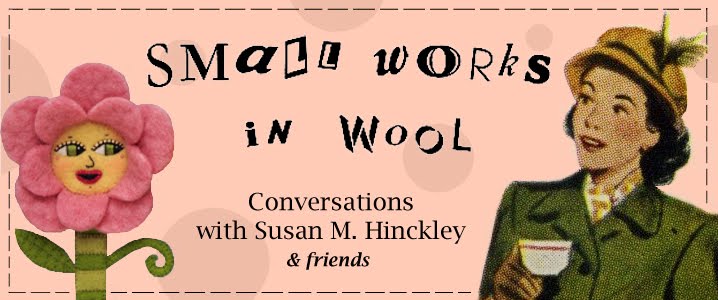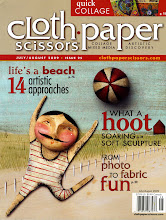Small Works Folk Art Week is going to feature two of my favorite African American artists. Because there are so many, it was hard to pick, so I chose the two I know the most about.
Harriet Powers (1837 - 1911) was born into slavery. She was the mother of eleven children and two marvelous "story" quilts. The quilts are now in the collections of the Smithsonian and the Boston Museum of Fine Arts.
She was 49 years old when her children had left home, and she began the project of documenting her spiritual life. Since she could not write, she chose to record her diary with a needle and thread. The first quilt is made up of bible stories.

 On the left, the Crucifixion. On the right, Judas and the thirty pieces of silver.
On the left, the Crucifixion. On the right, Judas and the thirty pieces of silver.Harriet had a fascination with weather (as do I -- I'm a weather report junkie).

Her second quilt is like reading a record of meteorological events of the time.
 "Cold Thursday, 10 of Feb. 1895. A woman frozen while at prayer. A woman frozen at a gateway. A man with a sack of meal frozen. Isicles (sic) formed from the breath of a mule. All blue birds killed. A man frozen at his jug of liquor."
"Cold Thursday, 10 of Feb. 1895. A woman frozen while at prayer. A woman frozen at a gateway. A man with a sack of meal frozen. Isicles (sic) formed from the breath of a mule. All blue birds killed. A man frozen at his jug of liquor."There are also anecdotes about local people and events.
 "Bob Johnson and Kate Bell of Virginia. Rich people who were taught nothing of God. The independent hog which ran 500 miles from Ga. to Va. her name was Betts."
"Bob Johnson and Kate Bell of Virginia. Rich people who were taught nothing of God. The independent hog which ran 500 miles from Ga. to Va. her name was Betts."A local art teacher purchased Harriet's first quilt for $5.00 (although Harriet asked for $10, she was forced to accept $5 "Owin to de hardness of de times.") The art teacher allowed Harriet to visit her "child" whenever she wanted, and recorded all of the stories that accompanied her quilts. This makes it so that we are able to have Harriet's own words -- for this reason, I guess we'll forgive her about the $5 thing.
Horace Pippin (1888 - 1946) began his career in art by illustrating his spelling lists.
 Self-Portrait, 1941
Self-Portrait, 1941He is one of the most famous black painters of the century. He was unable to finish high school due to poverty; he was forced to work to support his mother. He was gravely injured in World War I, and took up painting when he returned in hopes of rehabilitating his right arm. He had limited use of the arm for the rest of his life, but it didn't keep him from creating his art.
His work explored slavery and social injustice,
 Old Black Joe, or "I's Comin", 1943
Old Black Joe, or "I's Comin", 1943 Domino Players, 1943
Domino Players, 1943as well as the horrors of war.
 The End of the War: Starting Home, 1930
The End of the War: Starting Home, 1930But I love his still lifes with their outlandishly large flowers.
 Summer Flowers with Two Chairs, 1944
Summer Flowers with Two Chairs, 1944 Red, Yellow and White Roses, 1941
Red, Yellow and White Roses, 1941Horace Pippin once said, "Pictures just come to my mind, and then I tell my heart to go ahead."
 Giant Daffodils, 1940
Giant Daffodils, 1940I can't help wondering what Horace might have painted to commemorate this week. I'm sure he and Harriet are both celebrating, somewhere.
I felt it was an honor to celebrate with them here.
Tomorrow -- last day of Folk Art Week! Here's a hint: some people have too much time on their hands. . .















3 comments:
hello horace. how i have missed you.
I thought folk art week might make you and Hannah a little homesick -- consider it a gift to get you over the hump until you get to come home at Christmas:)
I'm a fan of both artist! In fact, I'm working on abit of Harriet Powers research now. Thanks for posting the images. Best, Kyra
www.BlackThreads.blogspot.com
Post a Comment